49. Building a Data Culture in Retail: Fostering Curiosity and Continuous Improvement
In the current hyper-competitive retail environment, data is often touted as the “new oil” powering business success. But raw data alone isn’t a magic potion. The real game-changer is something less tangible: a data culture. This is the environment, mindset, and set of habits that encourage everyone in an organization to use data for decision-making, to ask questions fueled by curiosity, and to relentlessly seek ways to improve. For small and medium-sized retailers, building a data culture can seem daunting – after all, you may not have the resources of an Amazon or Walmart. But here’s the good news: fostering a data-driven culture is more about people and mindset than about budget. In this article, we’ll explore how SMB retail executives can cultivate curiosity and continuous improvement in their teams through data, and why doing so can transform their business.
Q1: FOUNDATIONS OF AI IN SME MANAGEMENT - CHAPTER 2 (DAYS 32–59): DATA & TECH READINESS
Gary Stoyanov PhD
2/18/202515 min read

1. Why Data Culture Matters (Especially for SMB Retailers)?
Data-driven companies outperform their peers – this isn’t just hype, it’s backed by hard evidence. A widely cited McKinsey Global Institute study found that data-driven organizations are far more likely to succeed: they are 23 times more likely to acquire customers, 6 times as likely to retain those customers, and 19 times as likely to be profitable.
Closer to the SMB space, Amazon Web Services reported that 65% of highly data-driven small businesses financially outperform their competitors, versus only 33% of those that don’t leverage data effectively. These numbers tell a clear story: embracing data isn’t just an IT project, it’s a strategic imperative for growth and survival.
For retail businesses, the need for a data culture is even more pressing. Retailers today face razor-thin margins, fluctuating demand, supply chain complexities, and customers whose preferences change with the latest TikTok trend. In this context, flying blind without data is downright dangerous. By fostering a data culture, you enable your organization to respond to changes with agility. When everyone from marketing to merchandising is plugged into the metrics that matter, your business can spot trends early (like a surge in online searches for a product), respond faster (by stocking up or adjusting pricing), and learn from each campaign or season to do better next time.
Perhaps just as importantly, a data culture can level the playing field for SMBs. You might not have millions to spend on R&D, but you likely have piles of information sitting in your POS systems, e-commerce platform, or social media analytics. Treating that data as a strategic asset – and creating a culture that uses it daily – lets you punch above your weight. It’s how a nimble local retailer can outmaneuver a slower big-box competitor in the neighborhood: by deeply understanding their customers through data and continuously fine-tuning the experience.
Finally, consider the risk of not building a data culture. The harsh reality is that many companies talk about being data-driven, yet few achieve it. According to a recent executive survey by NewVantage Partners, a whopping 72% of companies admitted they have yet to forge a truly data-driven culture. If you don’t take deliberate steps to instill data values in your organization, you could end up as another statistic – a company that invested in technology but never reaped the rewards because the people side of the equation was neglected.
2. What Does a Strong Data Culture Look Like?
Let’s demystify the term data culture. At its core, a data culture means that data-driven decision-making is integrated into every corner of your business. In a company with strong data culture, employees—at all levels—seek out data before making decisions, and they share insights freely as part of the workflow. One succinct definition comes from FullStory: “A strong data culture integrates data-driven decision-making into every corner of your business, empowering employees to identify opportunities and solve problems with insights.”. In practice, that means a few things are likely true in your organization:
Decisions Backed by Evidence: Whether it’s choosing a window display layout or planning next quarter’s budget, people seek out relevant data. It’s not that intuition and experience don’t matter, but they’re balanced with empirical evidence. You might still trust a seasoned store manager’s instinct, but you’ll ask them to validate it by looking at last year’s sales pattern or a quick pilot test.
Curiosity is Encouraged: Team members are comfortable asking “why” and “what if” at every turn. If a particular product is selling out fast, the team digs into why: Is it a new trend? Did a local event spur the demand? If online conversions dropped last month, they ask what if we change the homepage banner or tweak the pricing? Questions are welcomed, not seen as unwelcome challenges.
Data Access for All Who Need It: In companies with great data cultures, data isn’t trapped in silos or hoarded by a few analysts. Instead, data is accessible through user-friendly tools or dashboards. A sales associate can pull up their store’s daily performance on the tablet, or a marketing specialist can segment customer data without needing to write SQL queries. Democratizing data is key – if only a select few gatekeepers can get information, curiosity gets stifled quickly.
Continuous Improvement Mindset: Perhaps most importantly, there’s a mindset of continuous improvement. This echoes the Japanese concept of Kaizen – constant, incremental progress. Teams run experiments and see setbacks not as failures, but as learning opportunities. For example, if an email campaign underperforms, the question isn’t “Who messed up?” but “What can we learn and do differently next time?” Over time, this leads to significant performance gains.
Accountability and Trust: In a data culture, metrics and KPIs provide a clear scoreboard. This transparency creates accountability (everyone knows how their actions move the numbers) but also trust – because debates can be settled by looking at objective data, not by hierarchy or who talks loudest. It shifts the culture from opinion-driven to evidence-driven, which can be liberating and motivating for teams.
3. Fostering Curiosity: The Heart of a Data Culture
Curiosity is the driving force behind any data-driven organization. As a leader, one of the best things you can do is create an environment that not only allows curiosity, but actively celebrates it. Here are some ways to foster curiosity in your retail business:
Lead by Example with Questions: Make it a habit to pose thoughtful questions in meetings. Instead of stating, “This product isn’t selling because customers don’t like it,” ask “What are the factors behind this product’s low sales? Could it be a placement issue, lack of awareness, or something about the product itself?” When your team sees you, the executive, digging deeper and questioning assumptions, it signals that curiosity is not only safe, it’s desired.
Implement “Question of the Week”: This is a practice some data-driven companies use – feature a “question of the week” that someone in the team posed, and show how digging into data answered it. For example, “Why are weekend afternoons suddenly busier than mornings?” Then explore the data: perhaps a nearby mall closed (driving more traffic to your store) or a new social media trend is bringing folks in. Share the answer and outcome. This kind of ritual makes curiosity visible and contagious.
Train on “How to Ask Good Questions”: Sometimes employees aren’t used to being curious at work, especially if they come from top-down cultures. Offer a workshop or informal session on framing questions and basic data analysis. Teach concepts like the 5 Whys (asking why repeatedly to get to a root cause) as a game. If you invest in developing their inquiry skills, they’ll be more confident in voicing questions.
Safe Spaces for Ideas: Encourage brainstorming sessions where any hypothesis can be floated without judgment. Maybe someone wonders if playing upbeat music in the store would increase sales in the evening. Instead of dismissing it, say “Interesting – how could we test that?” Not every idea will be practical, but you want to reinforce that thinking outside the box with data is welcome. The moment people fear looking silly for a question or idea, curiosity dries up.
Data as a Story, Not a Lecture: Human beings are naturally curious when information is presented as a story or puzzle. When you share data with the team, frame it like a narrative: “Our website traffic is up 50% this month, but sales didn’t follow – that’s a puzzle. What could be happening?” This invites others to join in solving the mystery, rather than feeling like they’re being confronted with a boring report.
Consider the example of Walmart’s hurricane insight we mentioned earlier. It likely started with someone asking an offbeat question like, “What odd things do people buy before a hurricane?” That kind of curious question led to a legendary discovery (Pop-Tarts and beer sales spike before storms). If Walmart’s culture had been one where analysts were told only to “focus on the basics,” that insight might never have surfaced.
The lesson for SMBs: you don’t need massive data to allow curiosity to work its magic; you just need to encourage the habit of looking. Your team might find that a certain shoe style always sells out online in one size – could be an opportunity to adjust orders. Or they might notice customers often search your site for “gift cards” that you don’t sell – maybe it’s time to offer them. The opportunities hiding in your data only reveal themselves to the curious minds.
4. Continuous Improvement: Turning Insights into Action
If curiosity is the spark, continuous improvement is the engine that keeps your data culture moving forward. It’s critical that insights and questions lead to action, or else people will lose interest over time. Here’s how you can instill a continuous improvement mentality:
Promote a Test-and-Learn Approach: Shift the language in your company to talk about “experiments” and “pilots.” For instance, if you suspect a new store layout could improve sales, frame it as an experiment: “Over the next 2 weeks, let’s try moving these product displays and see what the data says.” By calling these changes experiments, you make it clear that results (good or bad) are simply data points to decide next steps, not final judgments on someone’s idea.
Speed Over Perfection: Retail moves quickly. Teach your team that it’s better to implement a 90% right decision now than a 100% perfect decision too late. Continuous improvement thrives on quick cycles. Did an experiment show a 3% lift in sales? Great – can you tweak it to get 5%? If something didn’t work, no need to assign blame – learn and launch the next test. This agile mindset keeps your organization from getting paralyzed by analysis.
Kaizen Teams or Champions: Consider appointing “continuous improvement champions” in different departments. These are folks passionate about trying new things and optimizing processes. Empower them to gather small cross-functional teams to tackle specific challenges with data. For example, a champion in operations might form a team to reduce stockouts in store, using data on inventory levels and sales velocity. They can brainstorm, implement a change, measure it, and report the result. These micro-innovations, celebrated and shared, build the muscle of improvement.
Use KPIs as Feedback, Not Targets Alone: Key Performance Indicators (KPIs) are crucial, but how you use them matters. Instead of treating KPIs as pass/fail goals only, use them as feedback for learning. If foot traffic is down 10% this month, that metric isn’t just a red mark – it’s feedback inviting you to investigate and act. Maybe a local competitor’s opening hurt foot traffic, so you respond with a special event to draw customers. When people see KPIs as dynamic and influenceable by their actions, they engage with the numbers more proactively.
Document and Share Improvements: Create a simple knowledge base or newsletter for your organization that highlights recent improvements and what was learned. “We changed our window display strategy in July, and foot traffic increased 15% – here’s what we did and what we think it means.” This not only recognizes the team involved but also spreads the lessons so others can build on them. Over time, this becomes a repository of your company’s best practices and experiments. It also prevents repeating mistakes because everyone has visibility into what didn’t work.
The effect of a continuous improvement culture is powerful. One retail client we worked with started encouraging small experiments in their stores. Initially, employees were cautious. One store manager decided to experiment with extending weekend hours for the holiday season in just one of his three stores, to compare performance.
He discovered that the store with extended hours saw a 8% sales increase, with minimal increase in staffing costs – a net win. He shared the data, and the next year all his stores adopted the change, contributing to a record holiday season.
This might seem like a simple, obvious tweak, but it hadn’t been tried before because the culture wasn’t encouraging tests. Once it did, improvement ideas started surfacing from all over – from how they arranged curbside pickup, to trying out localized Instagram ads targeting nearby college students. The key was that one experiment’s success gave others the confidence to try, and a framework to measure their success.
5. Steps to Build a Data Culture in Your Retail Business
Building a data culture is a journey, not a switch you flip. It involves strategic and deliberate steps. Here’s a roadmap to guide you:
Set a Clear Vision and Commitment: Start by articulating why data culture matters for your company. Link it to your business strategy. For example, “In the next 3 years, we aim to double our online sales – to get there, we need to leverage our customer data at every touchpoint.” Make it clear to your team that this is a leadership priority. Publicly commit to becoming a data-driven organization, so everyone knows this is not a fad of the month.
Assess Where You Are Now: Be honest about your current culture. Do people trust data or do they side-eye reports as “ivory tower stuff”? Are there tools in place for people to access data, and do they know how to use them? You might conduct a quick internal survey or hold roundtables to gather candid feedback. Identify pockets where data usage is strong (maybe your e-commerce team is already very data-oriented) and areas that lag. This assessment helps target your efforts.
Invest in the Right Tools (Scaled to Your Needs): You don’t need a multimillion-dollar system for a data culture, but you likely need something more robust than manual spreadsheets if you want everyone to engage. This could be as simple as adopting a user-friendly business intelligence (BI) tool or dashboard software that connects to your sales and inventory data. Many affordable cloud-based analytics tools cater to SMBs. The key is to choose tools that make insights easily accessible and visual. If it takes 10 hours and an IT request to get a sales report, curiosity will die on the vine.
Build Data Literacy: Technology is half the equation; people are the other half. Offer training sessions to get your staff comfortable with the data tools and basic analytics. This might mean bringing in a trainer, subscribing to an online course, or even leveraging your in-house experts to run lunch-and-learns. Teach people how to interpret a trend line, what a variance is, or how to run a simple A/B test. When employees feel capable, they’re more likely to dive in and explore.
Lead with Quick Wins: Don’t try to boil the ocean in the first year. Identify 1-3 high-impact areas where data could make a visible difference relatively quickly. Maybe it’s optimizing staff scheduling using sales data to reduce labor costs, or analyzing email campaign data to improve open rates. Tackle those with a cross-functional team and publicize the results. Quick wins create momentum and convert skeptics. When others see a colleague’s project save money or boost sales thanks to data, they’ll think, “Maybe I should try that.”
Integrate Data into Routine: Change your meeting habits and workflows to integrate data. Start executive meetings with a “metrics rundown”. Incorporate key numbers into performance reviews (“How did you use data to improve X this quarter?”). When approving new initiatives, ask for the data rationale or how success will be measured. These practices reinforce that data isn’t an afterthought – it’s central to how you operate.
Encourage Cross-Pollination: Often, the richest insights come at the intersection of departments. Create opportunities for teams to share data and collaborate. For example, hold a monthly huddle where each department presents one interesting trend or insight they discovered. Your marketing team might share, “Online searches for ‘sustainable products’ on our site jumped 30% this month,” which might inspire your merchandising team to highlight eco-friendly items in stores. Breaking down silos is crucial; a data culture thrives in an environment of openness.
Recognize and Reward Behavior: As the culture shifts, recognize those who are embracing it. This could be through formal rewards (like a “Data Driver of the Month” award) or informal shout-outs. Highlight stories of team members using data in creative ways, even if the results weren’t blockbuster. The goal is to make heroes out of the curious and the improvement-minded. Others will see this and understand what the company values.
Stay the Course (Persistence): Culture change doesn’t happen in a quarter or even a year. There might be excitement at first, then a dip in enthusiasm as day-to-day fires distract everyone. It’s important to stick with it. Keep talking about data in communications, continue training new hires in these values, and refresh your approach as needed. Sometimes turnover in staff can actually help if you consciously hire new people who thrive in a data-driven environment, to infuse fresh energy.
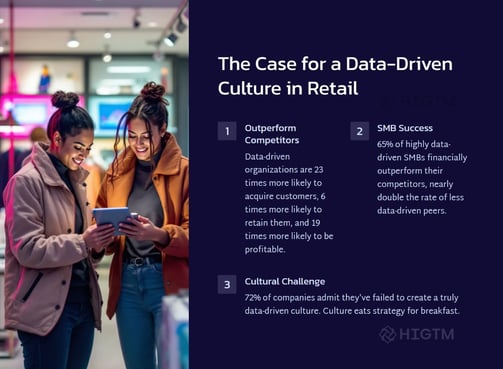


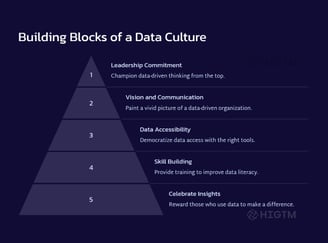
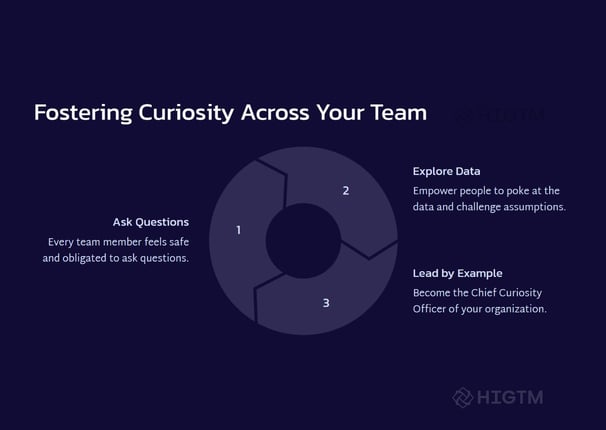

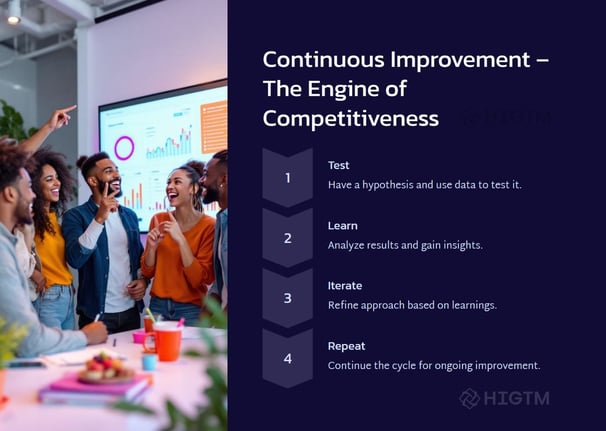

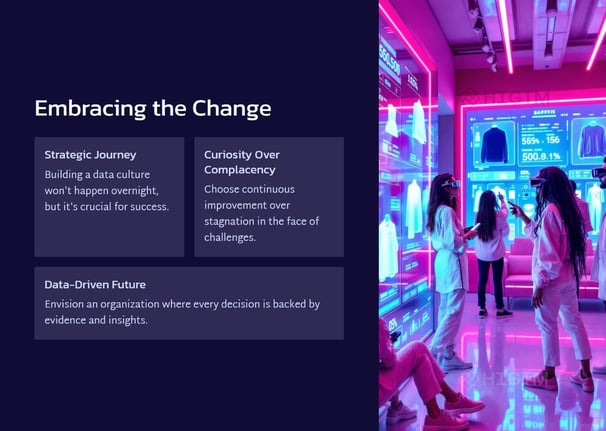

6. Overcoming Common Challenges
On the road to building a data culture, expect to encounter a few bumps. Here are common challenges and how to address them:
Employee Resistance or Fear: Not everyone will jump on the data bandwagon eagerly. Long-time employees might feel their experience is being devalued, or they might be anxious about “all these numbers” if they aren’t analytically inclined. Combat this by framing data as a support for their expertise, not a replacement. Provide plenty of support and reassure that their knowledge plus data equals a powerhouse combination. Pair resisters with data-savvy mentors. And most importantly, do not penalize initial missteps with data – otherwise fear will take root.
Data Quality Issues: “We tried looking at the data, but it’s a mess or not accurate,” is a refrain that can quickly sour enthusiasm. It’s true – if your data is full of errors or inconsistencies, people will throw up their hands. As you foster culture, also invest in data quality. Clean up duplicates in your customer database, ensure your sales systems are recording information correctly, and set up a process to regularly audit key data points. When people trust the data, they will use it more.
Siloed Systems: You might have one system for in-store sales, another for online sales, and yet another for customer service. If they don’t talk to each other, getting a “single source of truth” is hard. Consider integrating your systems or using a tool that can pull data from all and display it together. Even if full integration is a long-term project, you can start by manually combining data for analysis on key projects to show the value. Make integration a goal in your data strategy.
Analysis Paralysis: Occasionally, teams might get so deep into analysis that they hesitate to act. This can be countered by reinforcing the test-and-learn approach. Set boundaries like time limits for analysis phases or scope for experiments. Encourage a bias for action: “Let’s get the data, make our best decision, and see what happens – we can always adjust.” Sometimes 80% confidence is enough to move forward; the remaining 20% you can figure out on the fly.
Maintaining Momentum: After the initial push, keeping the energy up is tough. This is where making data culture part of onboarding new employees helps – it keeps fresh folks coming in who see this as the norm. Also, periodically bring in external inspiration: invite a guest speaker or consultant (like HIGTM 😉) to share stories of other companies’ data culture wins. It re-energizes and provides new ideas. Consider annual culture surveys to measure progress; if people see improvements, it validates the efforts.
7. Conclusion: Transforming Retail Through Culture
Fostering a data culture of curiosity and continuous improvement is a transformational journey for any retail organization – and it’s one that pays off. By embedding data-driven thinking into your company’s DNA, you create a business that’s not only more efficient and customer-centric, but also more innovative and resilient. In a sector as dynamic as retail, those qualities are your competitive edge.
It’s worth reiterating: technology alone won’t give you a data culture. It’s leadership and people. Your role as an SMB retail leader is to champion this cause, to exemplify the curiosity you want to see, and to nurture the habit of continuous improvement daily. The process might start with small steps – a pilot project here, a training session there – but it builds on itself. Culture change is cumulative.
Imagine a year or two from now: your marketing team eagerly awaits the weekly analytics report like it’s the next episode of a thriller series, because they can’t wait to see how their last campaign performed and what they can do better. Your store managers swap ideas on a company forum about insights from their sales data, each trying to one-up the other in a friendly competition of who can improve their metrics more. Your merchandising team uses dashboards to decide the next season’s lineup, confident they are in tune with customer trends.
This isn’t fantasy – it’s the reality of a company that has embraced data culture.
As a final thought, consider this powerful perspective: data culture is really about empowering your people. When you give teams the tools, permission, and encouragement to use data, you’re essentially saying, “We trust you to experiment, learn, and make things better.” That trust breeds engagement. Employees transition from doing a job to participating in a mission – a mission to continuously delight customers and outsmart the competition using the collective intelligence of the organization. It’s incredibly motivating to be part of that kind of workplace.
If you’re reading this and thinking about where to begin, the answer is simply: start now. Pick one area, one habit, one meeting this week where you can inject a bit more data-driven thinking. Share an insight from this article with your leadership team. And if you need guidance or an experienced partner to accelerate your journey, remember that you don’t have to do it alone.
At HIGTM, we’ve helped numerous retail SMBs cultivate winning data cultures, step by step. From assessing your current state to training your team and identifying quick-win opportunities, our experts act as your guide on this journey. If you’re ready to transform your retail business with a strong data-driven culture, reach out to us for a consultation. Together, let’s turn curiosity into actionable insights and continuous improvement into everyday success.
Your data holds the key to your future. Turn that key, unlock the potential – and watch your retail business thrive like never before.
Turn AI into ROI — Win Faster with HIGTM.
Consult with us to discuss how to manage and grow your business operations with AI.
© 2025 HIGTM. All rights reserved.
